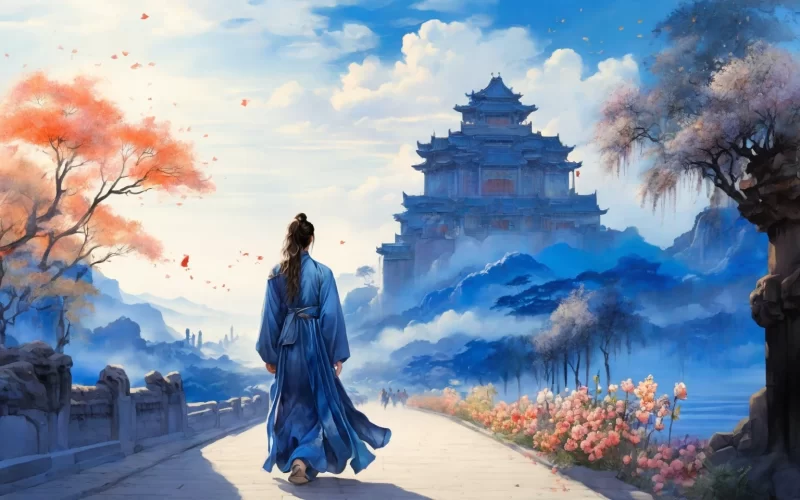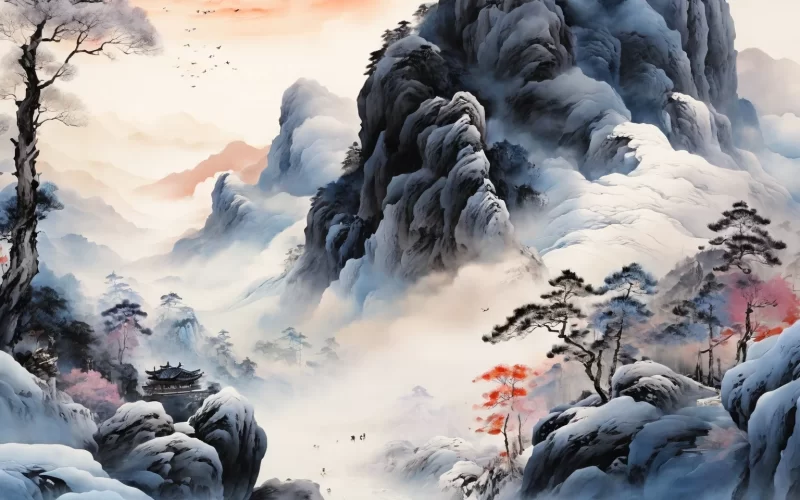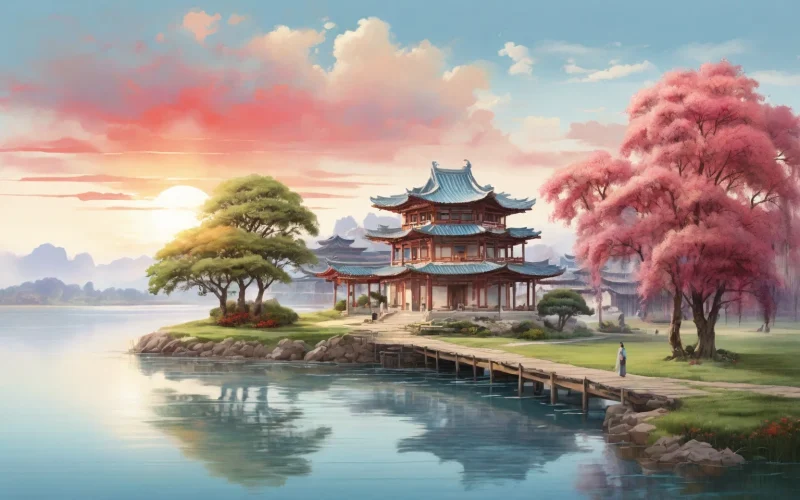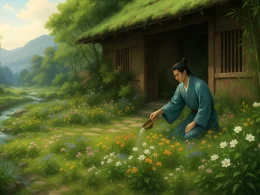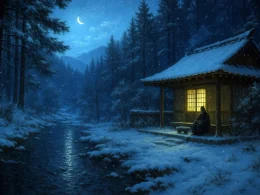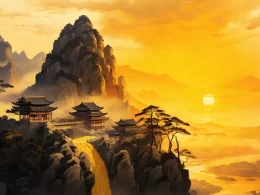The royal cab leaves palace hall
For poolside garden 'mid sweet songs.
The trees are loud with orioles' call;
On vernal shore grass grows in throngs.
The breeze can write with morning dew;
Neath blue sky flowers bloom like snow.
Butterflies come now and anew;
The hills are warmed by evening glow.
Original Poem
「早春桂林殿应诏」
上官仪
步辇出披香,清歌临太液。
晓树流莺满,春堤芳草积。
风光翻露文,雪华上空碧。
花蝶来未已,山光暧将夕。
Interpretation
This occasional poem, composed in response to an imperial command, depicts a spring outing in the royal gardens. Blending courtly splendor with natural vernal imagery, the poet creates a luminous tableau of seasonal renewal and aristocratic refinement.
First Couplet: "步辇出披香,清歌临太液。"
Bù niǎn chū pī xiāng, qīng gē lín tài yè.
The imperial palanquin departs Pixiang Hall's gate, While pure songs grace Taiye Lake's liquid state.
The opening establishes the regal setting through two iconic locations: the fragrant "Pixiang Hall" and the expansive "Taiye Lake." The "pure songs" suggest refined entertainment befitting the spring occasion.
Second Couplet: "晓树流莺满,春堤芳草积。"
Xiǎo shù liú yīng mǎn, chūn dī fāng cǎo jī.
Dawn trees brim with orioles' liquid call, Spring banks with fragrant grasses sprawl.
Nature's chorus comes alive through the orioles' morning song, while the spreading grasses embody spring's exuberant growth. The couplet balances auditory ("liquid call") and visual ("sprawl") impressions.
Third Couplet: "风光翻露文,雪华上空碧。"
Fēng guāng fān lù wén, xuě huá shàng kōng bì.
Sunlit breezes turn dew to tracery fine, Blossoms like snow against blue skies shine.
The poet's meticulous observation shines here: dew transforms into delicate patterns under morning light, while flowering trees resemble snow against the azure canopy. These ephemeral beauties epitomize spring's transient glory.
Fourth Couplet: "花蝶来未已,山光暧将夕。"
Huā dié lái wèi yǐ, shān guāng ài jiāng xī.
Butterflies still dance round blooms unspent, As warm mountain hues foretell day's descent.
The closing lines extend the scene into dusk. The persistent butterflies and softening light create a languorous transition from day to evening, framing the imperial outing as a harmonious alignment of human activity and natural rhythms.
Holistic Appreciation
The poem tightly revolves around two central themes—"early spring" and "imperial response"—blending natural scenery with courtly elegance. Rather than focusing on palace activities, the poet unfolds the passage of springtime from dawn to dusk through layered natural imagery, allowing the royal gardens and spring vitality to illuminate each other. Rich in visual artistry, the work resembles a scroll painting of an early spring excursion gradually unfurling before the eyes, embodying the court poetry tradition of maintaining genuine emotion within formal constraints.
Artistic Merits
The poem features polished language and exquisite parallelism, harmonizing courtly refinement with natural vibrancy. Its composition resembles a painting, with fresh and lively imagery. The poet skillfully employs a structure that combines movement and stillness with temporal progression, presenting the scenes of an early spring day in a step-by-step manner. This creates a bright, harmonious spring atmosphere infused with imperial grandeur, showcasing Shangguan Yi’s elegant, ornate, and meticulously crafted courtly style.
Insights
This poem demonstrates how Tang court poets could balance adherence to imperial themes while preserving a delicate sensitivity to natural beauty and poetic expression. It reminds us that even within formal constraints, poetry can still give rise to unique aesthetic charm and artistic allure, achieving a realm where scene and emotion merge, and form and spirit unite.
Poem translator
Xu Yuanchong (许渊冲)
About the poet
Shangguan Yi (上官仪, c. 608-665), a native of Sanmenxia, Henan, was an Early Tang court poet and statesman. He earned the jinshi degree in the first year of Zhenguan reign (627) and rose to the position of chancellor, before being falsely accused of treason and executed along with his son, becoming a victim of political struggles. His poetry inherited the palatial style tradition of the Southern Dynasties, creating the distinctive "Shangguan Style" known for its "intricate elegance and graceful charm."






